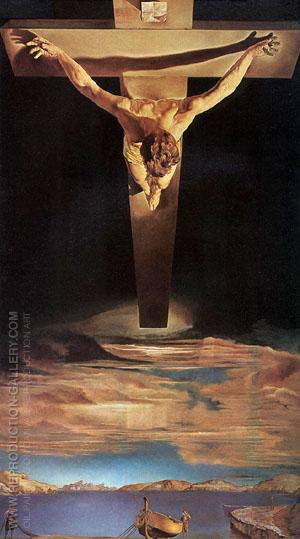[archiveorg Creed4CrucifiedDeadAndBuried width=640 height=140 frameborder=0 webkitallowfullscreen=true mozallowfullscreen=true]
   I‘ve never seen it in person, but I’ve seen copies of Salvador Dali’s painting Christ of Saint John of the Cross. Unlike more familiar presentations of the crucifixion where the cross is viewed from ground level, in Dali’s painting the cross is viewed from above, as if one were viewing it from heaven, from God’s perspective. The cross in the picture is massive; it looms over the whole world beneath. The figure on the cross seems to be holding back the darkness surrounding him. In the foreground, the earth, the sky and the sea are illumined by the light streaming forth from the cross.
   The whole world is viewed from the cross. And that is how we should see the world as well. For the cross is at the very heart of the Christian faith. That is why it is the primary identifying sign, the chief visual symbol of Christianity. The apostle Paul said, “May I never boast except in the cross of our Lord Jesus Christ, through which the world has been crucified to me, and I to the world.â€
   In the apostle’s creed, we say that Jesus suffered, was crucified, dead and buried. What do we really mean by these words? How did an instrument of torture and death become a subject of glory for the Apostle Paul?  And what does the cross mean for us now nearly 2000 years later?

   Bien que je ne l’ai jamais vue personnellement, j’ai pu voir quelques copies du Christ de saint Jean de la croix de Salvador Dali. Contrairement à d’autres représentations de la crucifixion où la croix est vu depuis le sol, dans l’oeuvre de Dali la croix est vue depuis le dessus, comme si quelqu’un regardait la scène depuis les cieux, depuis la perspective de Dieu. La croix dans ce tableau est massive; elle se dresse devant le monde entier. La figure sur la croix semble retenir les ténèbres autour d’elle. Dans le décors, la Terre, le ciel et la mer sont illuminé par la lumière provenant de la croix.
   Le monde entier est vu depuis la croix. Et c’est aussi comme cela que nous devrions voir le monde. Car la croix est au centre de la foi Chrétienne. C’est pour cela qu’elle est son premier sign distinctif, le premier symbole visuel du Christianisme. L’apôtre Paul dit, “Pour ce qui me concerne, loin de moi la pensée de me glorifier d’autre chose que de la croix de notre Seigneur Jésus-Christ, par qui le monde est crucifié pour moi, comme je le suis pour le monde.â€
   Dans le credo des apôtres, nous disons que Jésus a souffert, a été crucifié, est mort et a été enterré. Que signifient réelement ces mots ? Comment un instrument de torture et de mort devient un sujet de gloire pour l’apôtre Paul ?  Et que signifie la croix pour nous qui vivons plus de 2000 ans plus tard ?